Fourteen years ago, a fresh English major graduate, I was hired by a group of homeschool moms to teach their middle schoolers how to write and tutor writing with them one-on-one. They gave me the original IEW teacher-training VHS tapes and 3-ring binder, and I gave it a shot. A couple weeks later I had a stack of student paragraphs, which I stared at blankly. Sure, they had their adverb openers and they had retold the fable, but was that really all I was supposed to go for? So many sentences just didn’t make sense, but all I could tell them was, “we don’t say it like that” or “it doesn’t sound good.” That’s not helpful and it bothered me that I didn’t know why it didn’t sound good. To tutor writing, I realized I would need more than a checklist.
I wanted to write better myself and I knew that teaching others how to write better – that is, teaching them to fish (knowing how to write better) rather than giving them a fish (rewriting their draft for them or a mediocre grade and calling it good enough) – was a needed skill. This skill comes from tutoring writing, not from writing curriculum checklists. Individualized attention, honing work, improving ability, these are the practices that help our students’ writing improve. To tutor writing with individual students was – and is – highly rewarding. Although it can be painful and slow, to see students find their voice and become comfortable not only expressing their thoughts, but doing so clearly and articulately, is exciting.
I remembered the composition instruction – here and there, from parents, friends’ parents, a homeschool class in Washington State history – I had had as a homeschooled student. I knew meaningful feedback, constructive criticism, was hard to know, hard to give, and hard to receive. Writing is a piece of yourself – taking criticism is hard. Writing requires style, which can differ from person to person – what’s style and what’s flat wrong? One person’s writing advice can be the exact opposite of someone else’s. But all that I learned came from those various times when someone sat down with me and talked over what needed to happen to improve my work, not from the journal entries or vocabulary sentences I had to write from textbook assignments.
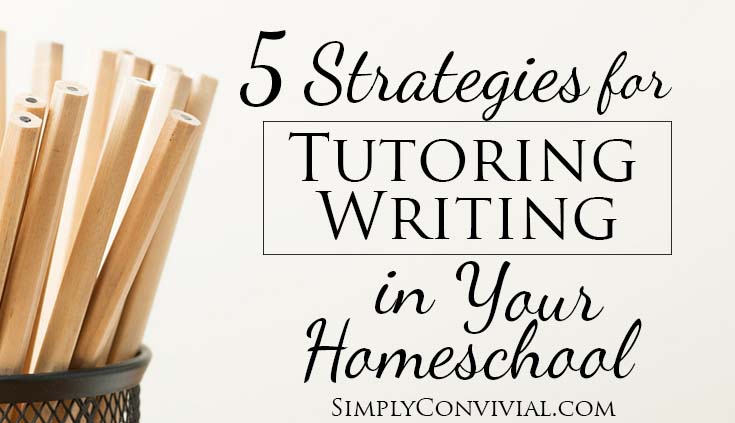
Writing is communication, and more than ever, all of us write. We write emails, we write Facebook updates, we write texts. Our children, in their young adult life right around the corner, will be writing college exam essays, scholarship essays, resume cover letters, love letters – written work that will shape others’ perception of them and affect their life. So how do we tutor writing with them?
So as we look over our kids’ paragraphs and try to help them develop into clear writers with elegant prose and a command of both their thoughts and the words they clothe them in, it’s no wonder we’re overwhelmed and at a loss. What can we tell them that will be helpful? How can we give criticism that is also encouraging and actionable? How can we help them with this paragraph such that their next one is better. How can we tutor writing skill?
That is, how can we tutor writing to improve our children’s ability and style and confidence with words?
Here are 5 ways I’ve come up with in my over ten years of teaching & tutoring writing to middle school kids, including my own two current middle schoolers, both of whom could already hold their own in an English 101 class (only because the current standards of composition in our society are abysmal, not because they’re amazing).
Tutor Writing Tip #1: They can’t write without material to work with.
This is priority #1. When parents with elementary kids ask about what they should do for composition, my answer is read, read, read – the kids should read, the parents should read to the kids, the kids should read aloud themselves, and there should be audio books and memory work as well. Hearing and seeing and saying correct English, beautiful English even, will develop their ear, their style, and their vocabulary better than any program.
Good writing says something. Before our kids can write, they have to have things to say. Young children will not be able to write well because they don’t yet have anything to say – they need to build that up over years of reading and living first.
The practice of having students retell fables as a beginning writing technique – like IEW and most classical writing programs – is a smart one, because it gives the students something to say. You can work on the mechanics of composition without worrying about what the content should be. Written narrations are also a way to practice writing skills without having to come up with something to say.
However, the best preparation for writing in the elementary years is not writing practice, but knowledge gathering and language acquisition.
Tutor Writing Tip #2: Require less output, but more revision.
Writing is mentally taxing, and revision is relationally taxing (it is criticism and correction, after all). More is not better. More is stressful. You need just enough to practice, little bit by little bit, over the course of several years.
In writing as with most things, you get more of what you practice. If you require them to write, but do not require them to use correct spelling, correct capitalization, complete sentences, and good style, they will learn the habit of sloppy writing. It will not improve itself automatically over time. Good reading doesn’t automatically make good writers, though all good writers read. Practicing good writing techniques makes good writers. To tutor writing is to practice with them, over and over, until they get the hang of it. It’s better done slowly over a long haul than rushed and crammed.
One well-written, revised, improved paragraph a week is better than 5 mediocre paragraphs a week. Output matters less than habits being learned and practiced and honed. To tutor writing is to take the long view approach.
Currently, my third grader writes 2 sentences a week: a one-sentence narration twice a week. She gives it to me orally, and I write it with correct spelling, capitalization, and punctuation. Then she copies it. She also does spelling through studied dictation, copying one sentence a day. That’s the extent of her writing.
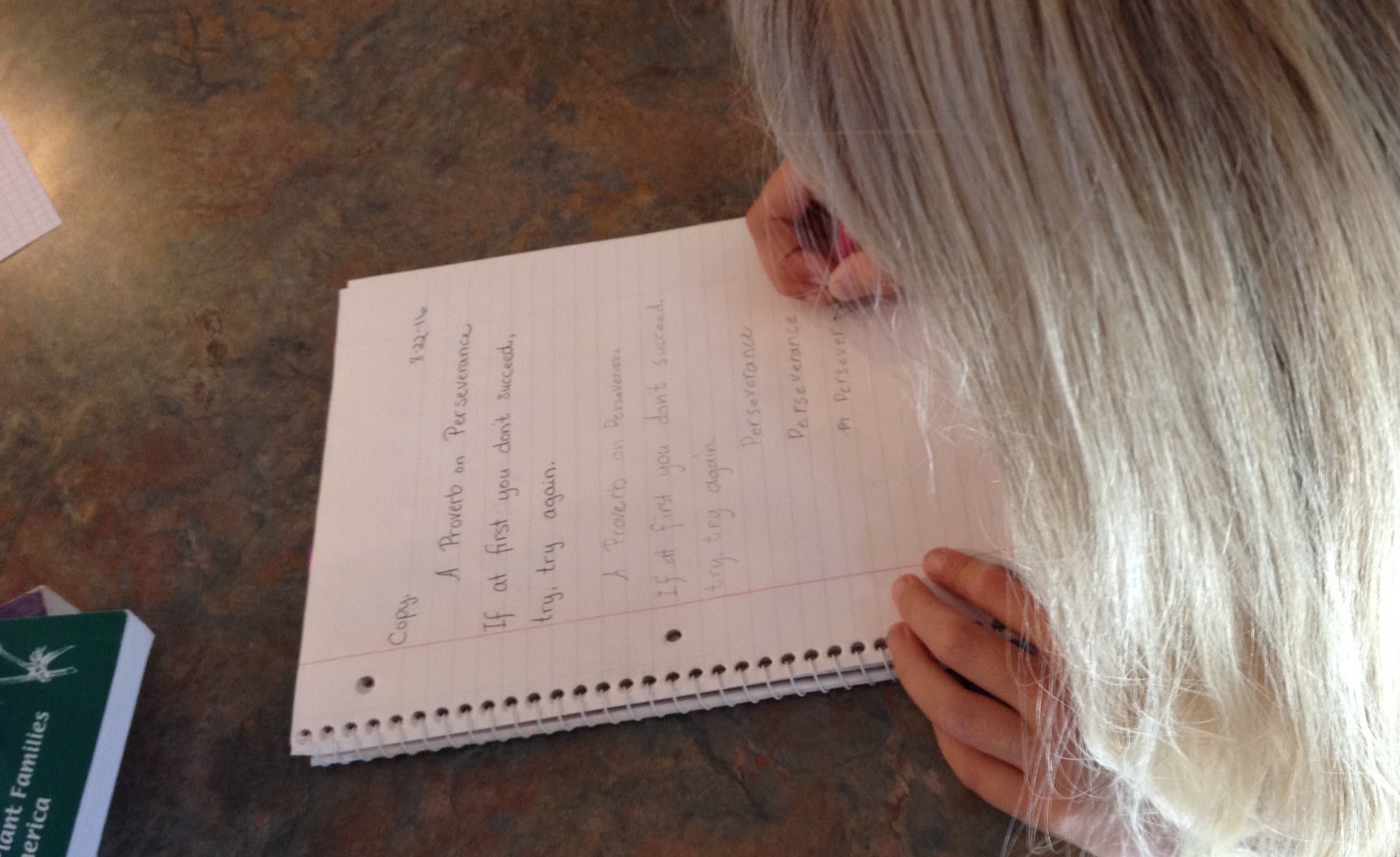
In fourth or fifth grade, learning how to write a paragraph is a skill that takes focused time. When I teach beginning writing to this age, using the retell-a-fable method I’ve modified from IEW, I start by requiring one paragraph every other week: the first week for composing, the second week for revising. By the end of the school year, they write one paragraph a week while also revising their previous week’s paragraph.
Currently, both my 6th & 8th graders (who have both had 2 years of direct writing instruction) write two paragraphs (written narrations) a week, which we go over the same week and always makes corrections, plus participate in a literature class (with me) where I have them write one 5-paragraph paper (with help, piece by piece) every 4-6 weeks.
One thing I always make sure all my own children and all my writing students know is that the first draft is never the final draft. All writers revise. They are writers. They will revise, improve, and correct. Just expect it, every time. All students resent having to rework something. It will take time for them to get used to it, but it’s a necessary step – always expect to rework writing. The first draft is never the final draft, we will tutor writing until I can say, “Well done.”
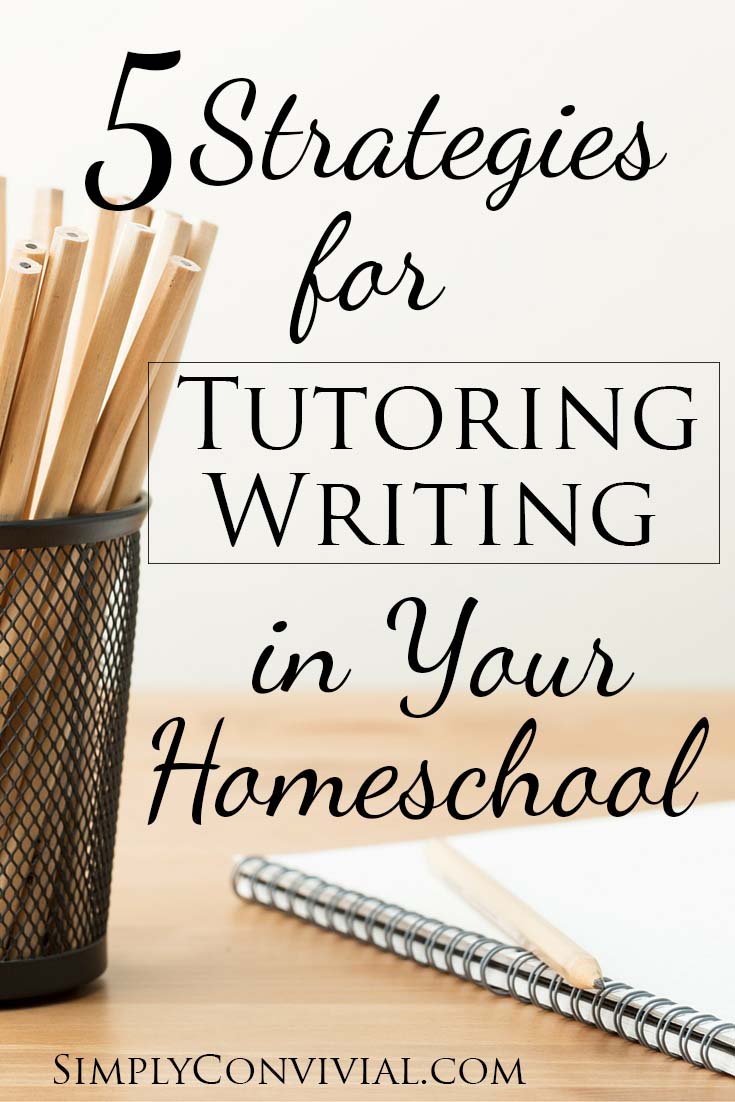
Tutor Writing Tip #3: Make all the revisions their revisions.
In college, I worked in the Writing Center, helping students with their papers. Mostly we corrected punctuation, pointed out incomplete and incoherent sentences, and helped Japanese students put article adjectives in the right places.
A cardinal rule for all Writing Center tutors was to never write on another’s paper. We could point and talk and suggest, but we weren’t to write directly on their paper. At first I thought this rule was just a silly self-esteem thing. But as I tutored, I realized that it was wise. If the tutors made the corrections directly ourselves, the students would just drop off their papers and be totally disengaged. By having to make the marks and corrections themselves, they were owning the changes. They had to be engaged and paying attention, and maybe they’d even learn something along the way.
Now, with younger students, I do write on their paper, because the act of writing can be tiring, but the older they get, the less I do. When I’m teaching a class and don’t have time to go over everyone’s paper one-on-one, I give feedback and suggestions on their drafts, but I always try to help them revise their own work themselves in class, also.
And here is where grammar study comes in handy. Grammar gives us the vocabulary to talk about their writing. I can say, “What’s the subject? What’s the verb? Is that subject really doing that verb, is that what you meant to say?” “You used an adjective here, but what word is it describing? That’s a verb, right? So what kind of description word to you need? Yes, an adverb.” Grammar comes to the rescue when we tutor writing, helping us communicate effectively about the words in front of us.
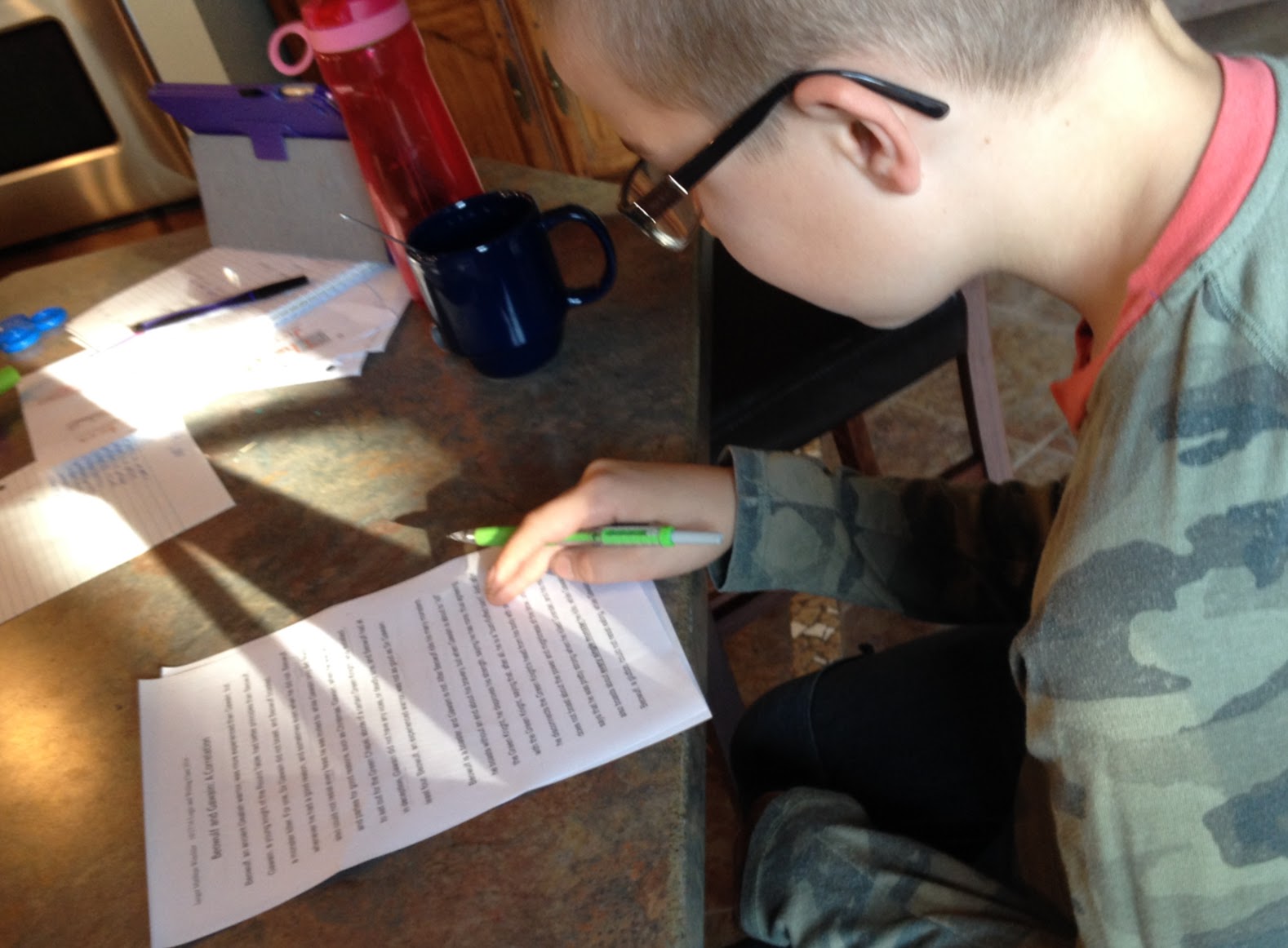
If all we can tell them is a vague “It sounds better if you say it this way,” they have no path forward to improve next time. When sentences are “fixed” without identifying any error, they believe that writing is entirely subjective and are more likely to give up trying to improve because the process is entirely a mystery.
When I make suggestions one-on-one – and the student is the one with the pencil and draft in hand – I point things out and say something like, “Every sentence here begins with a subject, but you don’t really need to add any new information. You can just rearrange what you have. Do you see any clauses you could move to the beginning of a sentence? Do you have any adverbs you could move to the beginning?” or “Your paragraph is all about one thing and all on point, it’s just not the same point as your topic sentence makes. You don’t need to change the whole paragraph to match the topic sentence, just change the topic sentence – what would you say the point of this paragraph is?” or “You use ‘good’ three times in two sentences here. How else could you say it here to mix things up?”
Tutor Writing Tip #4: Focus on the three dimensions of strong writing.
IEW is a sound writing program, but when I taught it as-is from the first edition I was given, the students’ writing – even from the good writers! – was convoluted and awkward. Personally, I detest flowery writing, and adding all the styles and all the openers, plus a decoration made their writing confusing and often hyperbolic. So I use their method to teach the strategies of openers and styles, but do not require them to use everything every time – they are the method to tackle specific problems encountered in the revision process.
These are the three factors I look at when I assess writing:
Cohesion: Every detail, piece of information, or opinion should relate to the topic at hand.
Written work should not be a long-winded ramble (for the wordy students) nor a disjointed set of 5 sentences to fulfill the requirement (for the reluctant students). It should be about something, tell about that one thing, and wrap up with a conclusion.
Stay on point, even if the point is not an opinion, but a historical or scientific narration. If the student puts something in parenthesis, it’s a sign that even he realizes this doesn’t belong – he just wanted to say it. Find out why he wanted to say it, see if it can be made to relate through actual connection, or if you’ve found the topic for his next paragraph, or if he was unclear about something.
So, for example, my middle schoolers’ written narrations never include all the details they’ve read. They will pull out one person or one event or one thought and write a paragraph telling about one thing. Maybe this isn’t authentic-enough narration, but it is good writing, and that’s higher on my own priority list.
Cohesion is probably one of the most difficult skills to tutor in writing, but it’s what separates wordy and vague writers from the clear and succinct. It has to be taught – to be tutored – intentionally.

Variety: The sentence rhythms – both length and type – should vary to keep it interesting.
This is where IEW’s techniques come in handy. Instead of only telling them that their writing sounds dull or monotonous, I can tell them: “Look, you used the same opener 3 times in a row. Let’s change that up.” or “Every sentence in this paragraph is a subject opener with a dependent clause – let’s switch some of those around and also try something different in a few – maybe a semicolon? maybe an appositive? Can we rework a couple of these to vary the rhythm?”
The same goes for overusing any particular word or using bland words. When I tutor writing, I will highlight or circle words that have been overused, that communicate very little meaning, or that give a different connotation or meaning than intended. I’ll point out why I circled those words so we’re on the same page, and in the next revision, I expect to see different words or phrases there.
Vocabulary: Meaning should be communicated by nouns and verbs, with adjectives and adverbs used sparingly.
It’s easy to pile on the adjectives, difficult to choose a specific, concrete noun and active, vivid verb. Strong writing is in clear, accurate, bold, striking nouns and verbs. If a child is attempting to add meaning by adding adjectives, limit the number of adjectives to one per sentence (not counting articles) and instead help him select rich nouns and verbs.
Of course, there is always the thesaurus phase. My own rule of thumb is that students are only allowed to use words they know in their writing. A thesaurus is handy, but just because a word is listed as a synonym of “good” doesn’t mean it will have the correct meaning in the context of their paragraph. We should be striving for le mot juste, not the longest or most impressive word.
Be careful with pronouns, including (and especially) relative pronouns: that, there. These are often crutches for a lack of understanding. If the writer isn’t clear on the connections, vague words start popping up trying to mask the confusion. Sometimes, the writer is simply writing too quickly and it’s easier to say “That’s why blah blah blah….” No. What’s why? Can’t we just say what we have to say without “that’s why?” Let’s try.
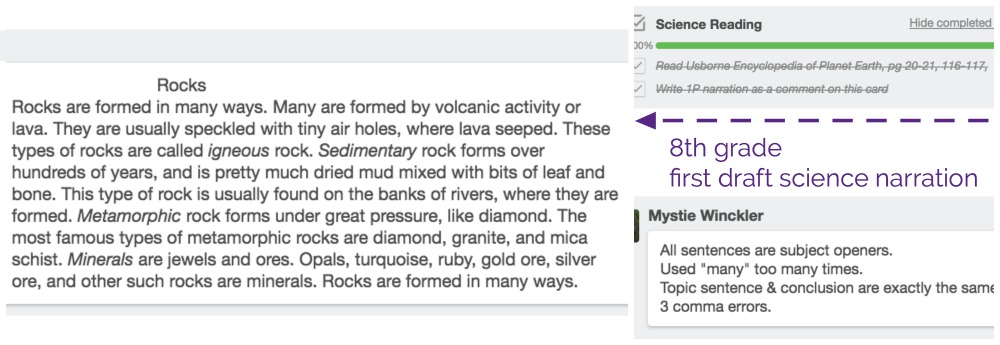
Try counting all the instances of “there” – especially in a story retelling. I like to challenge students to limit themselves to using it two times per paragraph, and then have them try without using it at all. These are exercises that force clarity of expression and writing with strong subjects and verbs, once the easy, “There once was a ….” so that the main meaning is now in a dependent clause. Take away the crutch, and they’re forced to say, “The princess lived long ago…” and now wordiness is eliminated, subjects are clear, and verbs are active. Just by taking away the privilege of saying “there.”
I do not make across-the-board rules governing adjective use or number of sentences per paragraph or other technicalities like that – they are teacher-crutches to make grading easier. But our goal is not to be done and check the box, but to say what we wanted to say and improve our style along the way. That means sometimes I forbid a particular word for a particular paper for a particular student, not because there’s anything wrong with the word, but because the student needs practice without it. Some students need a minimum length, some a maximum. It’s better to see what each student needs than to make a rule that makes it easy. Specialized, individualized requirements are what it means to tutor writing.
Tutor Writing Tip #5: Make them find the technical errors.
You don’t need any special curriculum for technical error finding. Just have them do it on their own work. I will sometimes tell my older students something like, “This paragraph has two comma errors. Can you find them?” This lets them know when they’re done and gives them a concrete goal, but puts them in the role of discoverer, analyzer, and proofreader rather than the passive recipient of corrections. When you tutor writing, you can help them become their own proofreaders and editors. But don’t get discouraged, it really will take years of practice.
These are the most common problems:
Commas:
- When two complete sentences are joined by a conjunction, a comma is necessary.
- When a conjunction joins two subjects or two verbs (which both take the same subject), do not use a comma.
- When two complete sentences are joined by a comma only and no conjunction, it is a comma splice; replace the comma with a semicolon or add a conjunction.
- When a sentence begins with a subordinate conjunction (like when, if, because, although), the subordinate clause is separated from the main clause by a comma; however, if the subordinate clause comes at the end of the sentence, there should be no comma.

Capitalization:
- Proper nouns (specific names) must be capitalized while common nouns should not be unless they begin a sentence.
- Kids often have letters they prefer to write as capitals rather than lowercase (particularly Ds, and sometimes S and others are made too tall so as to appear as capitals). I treat these as spelling errors that must be corrected in all work at any time when making corrections (even on math doodles) – use a pencil, erase the error, and write it correctly. Some targeted handwriting practice (like 10 lowercase d’s for every incorrect uppercase) is also an effective way to help break the habit.
Besides these errors, the basics of using the correct side of hole-punched paper, starting sentences with a capital, ending sentences with a period, and putting a name and date on the top is basic and should be done every time. It’s amazing how much reinforcement – i.e. repetitions! – these simple steps require!
One final formatting tip: Teach your students to always double space their writing, whether by hand or typed. It is for their own benefit! Not only is a double-spaced paragraph easier to read, it is also so much easier to make corrections. With a little carat, you can insert whole clauses into sentences without crowding or erasing. You can draw a line through a sentence and replace it with a new sentence above it – so much faster and neater than erasing and writing over half-erased words.
And, as you’re sitting with your writing student, tutoring writing alongside them, remember that the same principle applies to writing as it does to life: Write it down, right away. If the child says, “Well, I could add…” smile excitedly and respond, “Oh, yes! That’s good! Write it down!” No one is going to remember the specifics as well even thirty minutes later when sitting alone with the paper and a pencil (or the paper and a keyboard). Get the revisions onto the paper while you’re talking about them.
Tutoring writing is time-consuming and can be arduous, but it is one of the most worthwhile things you can do for your student. Expression and communication is a needed skill that requires hand-holding and practice – every week, for years. Hang in there and just take the next step, each time.
Read more about how I teach writing without a curriculum:

This is really fabulous, Mystie. Thank you. The writing curricula feel cumbersome (though many of them have some awesome ideas to glean) when you already have some intuitive idea what you’re doing when it comes to teaching/tutoring writing. I’ve outsourced middle school writing for my two oldest for this reason. I do better with helping in the editing and revising stages rather than the teaching phase. But some of these suggestions might help me undertake the whole shebang with my future middle schoolers.
I love to read your posts on teaching writing! Mostly, because I feel this is the area that is hardest for me to teach. Your posts always give me encouragement to keep going.
I would love to hear more about the 5-paragraph paper you are having your 8th and 6th graders write if you are willing to share. ;) Since my 8th grader finished IEW offered through our co-op last year, I have been struggling with what to do next and how to incorporate writing into her other subjects. Thank you for sharing your tips!
Timing on this couldn’t be better. I have a 7th grader who is in a homeschool group with other 7th graders. Several moms from the group were discussing issues with our students’ writing just yesterday. We have all of the issues you outlined above so I am so excited to try out your tips with my daughter. We also have another struggle – spelling. Several of our kids cannot spell worth a lick! One is dyslexic but the others just aren’t natural spellers. How do you handle misspelled words?
Mystie what do you suggest Moms do that don’t have writing/grammar skills themselves? I’m even getting SWB’s Writing with Ease workbook for my first grader, because I even need help with planning out copywork and narration:-) I know you don’t have a need for a middle school writing curricula yourself, but are there any you would recommend?
SWB’s First Language Lessons starts with narration and copywork, I believe. SWB’s programs, IEW, and Classical Academic Press all have good programs; in my opinion, though, they all start too early with too much extra busy work. :)
I’m using Spelling Wisdom from Simply Charlotte Mason for my third grader’s spelling copywork – I don’t have time or energy to come up with that myself. Although, with my older boys when I was pregnant and tired (and also not too worried about their spelling), I just had them slowly copy Psalms, whichever one we were memorizing at the time.
Earlier is not always better. Kids can get burnt out on trying to meet writing requirements before they’re even really able to compose. For first grade I only do copywork as handwriting practice and then reading, audiobooks, and Morning Time memory work constitute their language-building skills.
I’m extremely intimidated by the idea of teaching someone to write, but this is very helpful. Thank you.
As a teacher with 10+ years experience, approaching writing tutoring has long been a trepidatious task. Your advice and structure is extremely well-designed and constructive. Thanks!